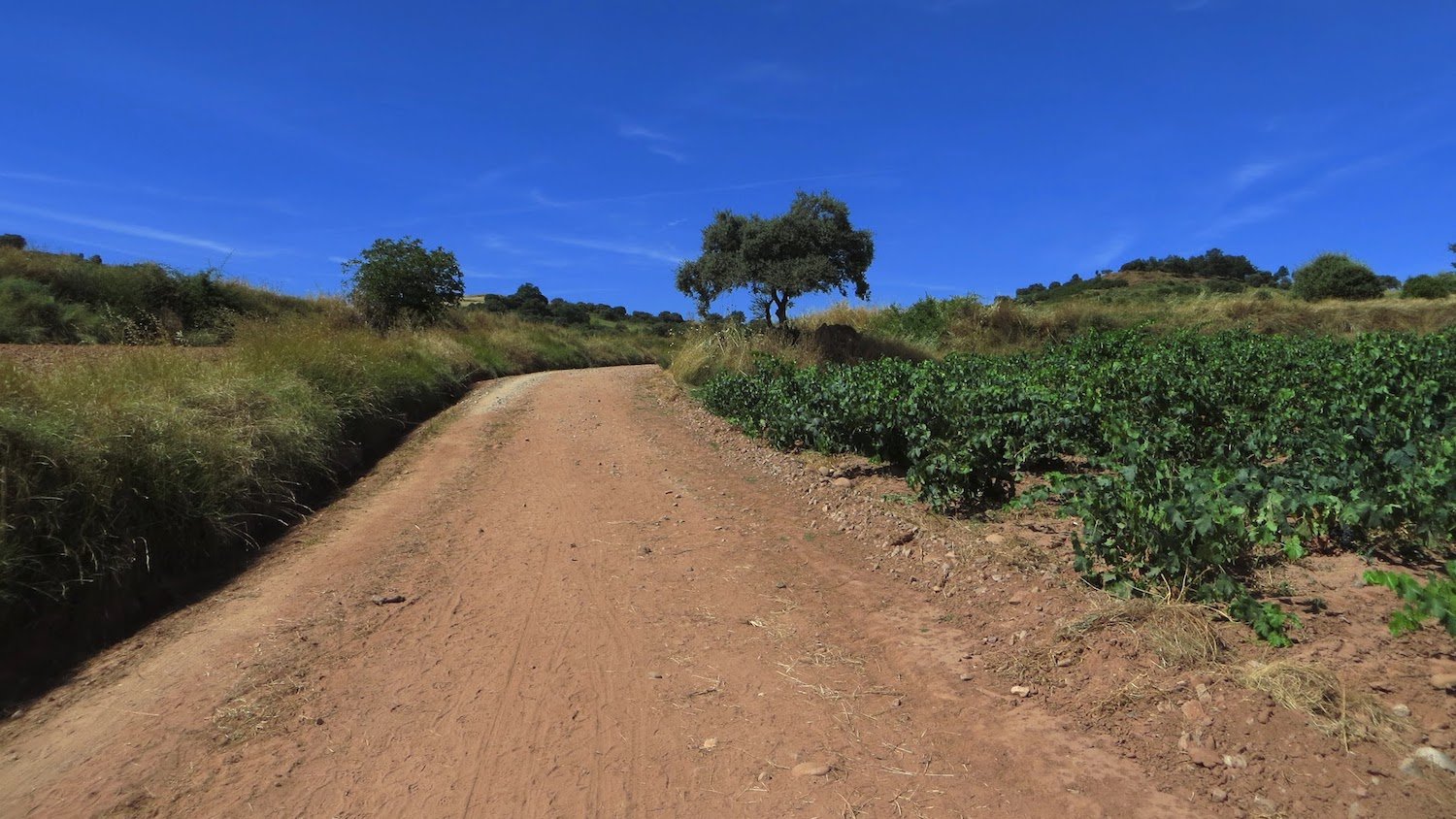The hills rose and fell like sea swells. They came unhurriedly, more splayed than steep. As soon as we reached the bottom of one, another began to build. Bob and I poled our way to the top of each, enjoyed the view, then dropped into the next trough. It went on this way, west of Logroño, for a long time.
Along our track were rows and rows of grapes. These were suspended on systems of wires and supports laid out with such precise intent that one could almost believe that a giant comb had been pulled across the hills. The mad tangles of vines, leaves, tendrils, and fruit--as tall as a man--had been disciplined to defy their own nature as well as the nature of the hills. They ran in their lanes straight and true. It was a viticulturalist's paradise.
More than three million acres of Spain are devoted to the production of wine. Here, along with Italy and France, the grape enjoys celebrity status.
Along our track were rows and rows of grapes.
A man appeared out of nowhere and inquired if we were pilgrims bound for Nájera. We affirmed the obvious. He asked to accompany us for a while. "I want to practice my English," he offered as an excuse. "And I need the exercise."
With little else to do but walk, we welcomed this stranger into the troop of Bob and Mark.
The usual pleasantries followed. We learned that his name was Alex and that his family had lived in the village of Navarrete forever and that he farmed nine hectares (about 22 acres) of vineyards. He had been tending the vines when he heard us coming.
"Do you know the story of the Camino?" His English was Spanish-stained but it was clear enough.
Bob and I had notions of course, but we welcomed his company. We also welcomed the conversation that his question would set in motion.
"No. Tell us."
Alex looked pleased. He slipped between me and Bob as we poled our way over another crest.
Tink—tink—tink. The silver cap of my walking stick tapped the stones.
The grapevines are disciplined to defy their own nature.
The grape farmer began by going over the usual details: how James was one of Jesus's key men, how he had come to Hispānia in both life and death, and how his tomb had been rediscovered in the time of King Alfonso II. (If you are just now joining us, you really should go back and read our previous stories. Here’s the place to begin.) As these details were rehearsed, it was obvious that Alex was skeptical of the tale. I squeezed him for an opinion about the identity of the tomb in Santiago de Compostela, the pilgrim destination.
"I don't know if James is really there or not," he said. He winked and apologized. "My English is not so good."
"It's great," we affirmed and laughed. "Better than our Spanish."
We stopped at a fork in the road.
"If we go this way," Alex offered, "we'll go to the village of Sotés. It's the longer and harder way. If we go the other direction, we follow the highway. It's up to you."
We chose the highway. "Good," he said (as if it made a difference to him), and continued his story.
The La Rioja region of Spain is famous for its wines. The secret, in part, is in the climate. The region is protected by the nearby Cantabrian Mountains. Image from here (accessed 8/29/2018).
"The tomb of James was the excuse." He went over select details of the Reconquista and how the Christians were fighting the Moors in Hispānia and how Christian leaders encouraged settlement. The leaders knew that if people walked to Santiago de Compostela they would discover how beautiful the land was and stay. He waved his hands at the rolling green hills as proof of the assertion. This is why his family had lived here forever and farmed nine hectares of grapes.
Bob and I nodded, duly impressed.
This flow of travelers strengthened the connection between the Iberian peninsula and the rest of Europe.
I knew from my own reading that by the tenth century northern Hispānia was firmly in Christian hands. After another century the Camino Francés would come into its "golden age." More than 250,000 pilgrims would walk the path each year, their feet etching the path into the earth. The Codex Calixtinus, a guidebook to the stages of the trail came together in the twelfth century, and with that move, the trail was more or less "canonized." It was etched in both earth and parchment.
We genuinely enjoyed the company of Alex. He was knowledgeable and engaging, a historian as well as a farmer.
We came to a park beside the trail. Alex wound down. "Now I must walk back."
I wondered what would come next. In the Middle East, the conversation at this point would turn to something about 'visiting my cousin's store for shopping.' There was no such pitch here. Alex's motives were genuinely altruistic. We parted as Camino friends. Bob and I would continue to Nájera. Alex would return to tending his vines.
I thanked him and shook his hand warmly. "I am a teacher, but today you have taught me."
The grape farmer seemed pleased.
¡Buen Camino!
Three men tread grapes. This 2nd century AD mosaic is from the Amphitheatre House, Merida, Spain. It illustrates a part of the job of wine-making. Image from here (accessed 8/29/2018).
Eager to get back out there? So are we!
If you are interested in seeing wine country with your own eyes, you really should join Mark and Vicki for a Mediterranean cruise! Click the link here for a future travel schedule. We visit biblical sites on the Mediterranean rim and contemplate places where the grape, olive, and fig still hold celebrity status.






